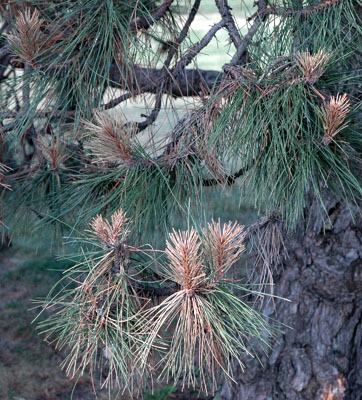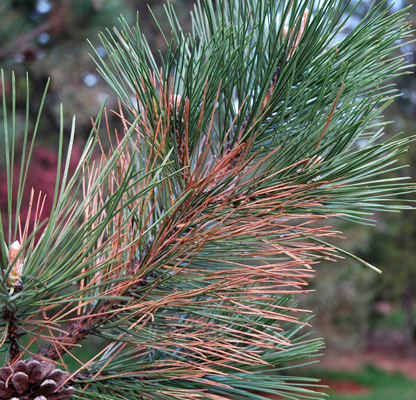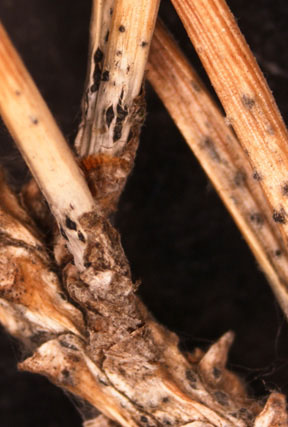Issue 4, May 15, 2009
Pine Tip Blight
Here's a disease that has become very, very common in Illinois. Diplodia tip blight causes the needles to die at the tips of branches, as seen in the first image. Additionally, it may cause sappy cankers on stems, girdling and killing the tissue beyond the cankers. This disease can make your pine look very unattractive without quite killing it. Look around your town and you will find many cases of Diplodia blight.

Many growers confuse Diplodia tip blight with Dothistroma blight. Dothistroma blight of pine was discussed in issue #3 of this newsletter. Keep in mind that Diplodia causes symptoms on new growth and Dothistroma causes symptoms on one-year and older needles. The second image shows the older needles affected when Dothistroma needle blight is present.

Diplodia tip blight is caused by a fungus, Diplodia pinea. This fungus forms fruiting bodies (containing spores) on the affected needles. The fruiting bodies are black, about as large as the head of a pin, and are embedded in the pine needle. The third image shows these fruiting bodies on infected needles just after a rain event.

Research has shown that drought stressed trees and trees growing in high nitrogen situations are more likely to be infected. Wet spring weather also promotes infection of new shoots. There are several practices that can help reduce the amount of damage caused by Diplodia blight. Reduce tree stress through mulching and timely watering. Removal of dead stems is helpful, but only in dry weather so as to avoid spreading the fungus. Since the fungus survives on cones, rake and remove fallen cones throughout the season. Chemical options are available but are often too late once symptoms are visible. When fungicides are used, consider systemic products and apply three applications: (1) when buds begin to elongate/swell, (2) just before new needles emerge from the sheath, and (3) 10 to 14 days later. We have already passed the timing for the first two sprays this year. Concentrate on cultural management options this year.
For the future, trade names of registered fungicides, along with mobility of the products, can be found in the Illinois Commercial Landscape and Turfgrass Pest Management Handbook or the Home, Yard, and Garden Pest Guide. Azoxystrobin, chlorothalonil, myclobutanil, thiophanate-methyl, propiconazole, and triadimefon are the active ingredient options.
For more on Diplodia blight, consult report on plant disease 625, available on line.--Nancy Pataky
Author:
Nancy Pataky